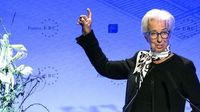On April 7, 2025, the Euribor, the interest rate at which major European banks lend money to each other, fell to 2.210%, marking its lowest point since September 2022. This decline is significant as it comes amidst ongoing economic uncertainties and expectations of future interest rate cuts by the European Central Bank (ECB).
The drop in the Euribor is a direct response to various financial pressures, including the repercussions of a trade war initiated by the United States under former President Donald Trump. This situation has led to a reevaluation of economic conditions across Europe, with experts suggesting that the ECB may consider lowering interest rates in their upcoming meeting scheduled for April 17, 2025.
According to financial analysts, the recent decline in the Euribor could lead to substantial savings for homeowners with variable-rate mortgages. For instance, a variable mortgage of €150,000 over 30 years with an interest rate of Euribor plus a spread of 0.99% could see monthly payments decrease by approximately €109.46. If the mortgage is reviewed semi-annually, this could result in annual savings of €671.11.
The implications of the Euribor's decline are already being felt. In March 2024, the Euribor was at 3.718%, and the average for April 2025 has been temporarily set at 2.272%. This shift represents a significant reduction in borrowing costs, especially for those whose mortgages are tied to this index.
Furthermore, the trend appears to be encouraging for those considering refinancing their mortgages. Sergio Carbajal, a mortgage expert from Rastreator, noted that switching from a variable to a fixed or mixed-rate mortgage could be beneficial, provided that the costs associated with changing lenders are manageable. The penalty for canceling a mortgage with the original bank typically stands at around 0.5% of the outstanding capital, which could amount to €1,000 for a €200,000 mortgage.
Despite the positive news for borrowers, the situation is not without its challenges. Recent data from the National Institute of Statistics (INE) shows that operations involving the change of mortgage lenders have decreased by 62.8% compared to January 2024, indicating a cautious approach among homeowners.
Looking back, the Euribor has undergone significant fluctuations over the past year. In early 2024, the average stood at 3.675%, down from 4.022% in 2023. This downward trend has provided relief to many homeowners who had faced escalating monthly payments due to rising interest rates in previous years. In October 2022, the Euribor reached a peak of 4.16%, the highest level since 2008.
The current economic climate has led to a notable change in consumer behavior as well. According to a recent survey conducted by Fotocasa Research, the percentage of Spaniards purchasing homes without the need for a mortgage has risen from 27% in 2022 to 35% in 2024. This shift suggests that more buyers are opting to buy homes outright, possibly due to the increased costs associated with variable-rate mortgages.
As the financial landscape continues to evolve, many are left wondering what the future holds for interest rates and mortgage payments. The upcoming ECB meeting is highly anticipated, as it may provide further insights into the central bank's strategy in response to the ongoing economic challenges.
In conclusion, the recent decline in the Euribor signals a potential turning point for borrowers in Spain. With the prospect of lower mortgage payments on the horizon, many homeowners may find themselves in a more favorable financial position. However, the broader economic implications of the trade tensions and the ECB's policy decisions will continue to shape the landscape of borrowing and lending in the months to come.







